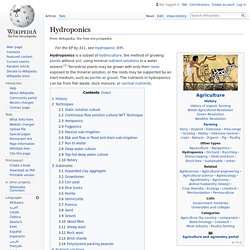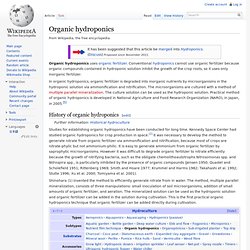

Hydroponics. NASA researcher checking hydroponic onions with Bibb lettuce to his left and radishes to the right Hydroponics is a subset of hydroculture, the method of growing plants without soil, using mineral nutrient solutions in a water solvent.[1] Terrestrial plants may be grown with only their roots exposed to the mineral solution, or the roots may be supported by an inert medium, such as perlite or gravel.

The nutrients in hydroponics can be from fish waste, duck manure, or normal nutrients. History[edit] In 1929, William Frederick Gericke of the University of California at Berkeley began publicly promoting that solution culture be used for agricultural crop production.[3][4] He first termed it aquaculture but later found that aquaculture was already applied to culture of aquatic organisms.
Organic hydroponics. Organic hydroponics uses organic fertilizer.

Conventional hydroponics cannot use organic fertilizer because organic compounds contained in hydroponic solution inhibit the growth of the crop roots, so it uses only inorganic fertilizer. In organic hydroponics, organic fertilizer is degraded into inorganic nutrients by microorganisms in the hydroponic solution via ammonification and nitrification. The microorganisms are cultured with a method of multiple parallel mineralization. The culture solution can be used as the hydroponic solution. Practical method of organic hydroponics is developed in National Agriculture and Food Research Organization (NARO), in Japan, in 2005.[1] Science In Hydroponics.